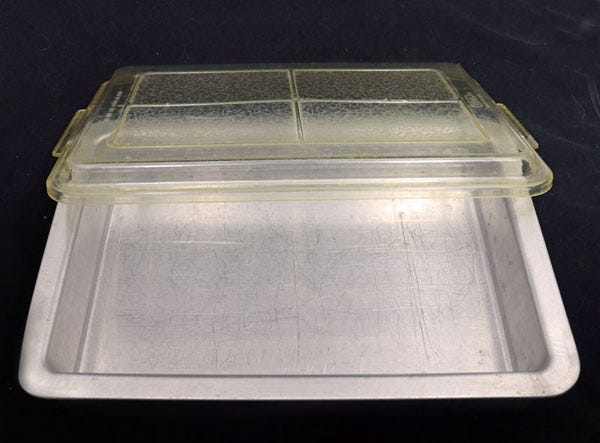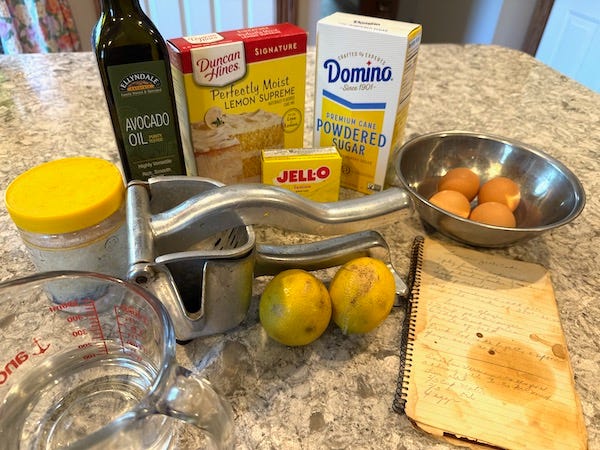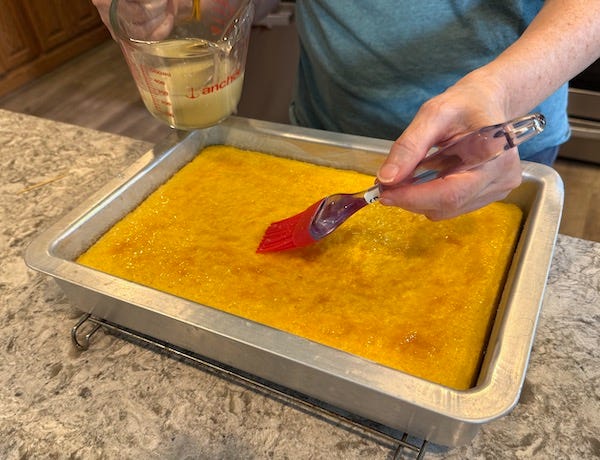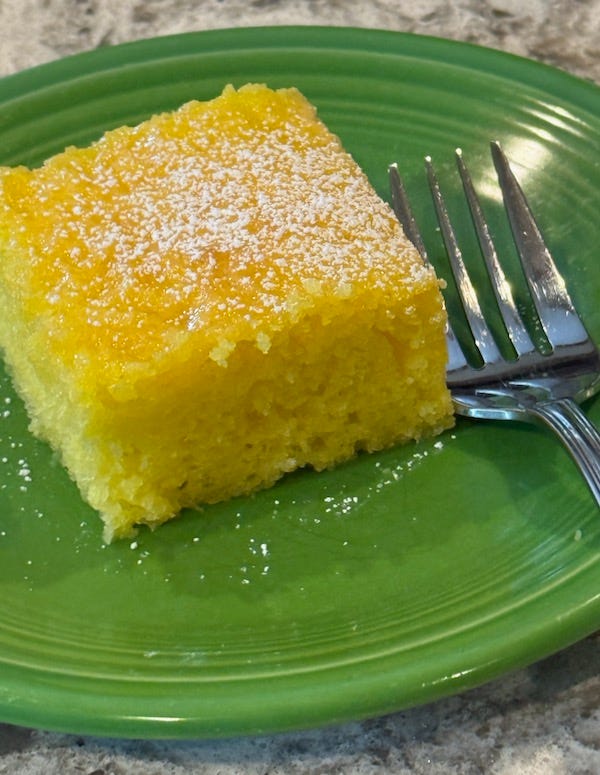Tucked into a spiral-bound notebook, my mom left behind more than just ingredients and instructions—she left a legacy. Some recipes are scrawled in pencil, others marked in ink, all of them shaped by the warmth of her kitchen and the community around her. This series revisits those handwritten treasures, one dish—and one memory—at a time. This is the second in the series.
As I’ve mentioned before, I can’t remember a time growing up when there wasn’t cake, pie, or cookies in our house. One of Mom’s main staples was sheet cake. She’d bake it in a half-sheet pan, ready for the neighborhood kids when they came by to play hopscotch, four square, or just hang out.
Over the years, I'd often thought about that cake but could never quite remember what it was. It wasn't chocolate—though I'm sure Mom made that too—and it wasn't a plain white cake. Then, in the 1980s, while working downtown, some friends and I went to lunch at a little hole-in-the-wall spot on 4th Street. On the counter sat several pieces of lemon cake. They looked like Mom's sheet cake. One bite and I was transported back: slightly tart, sweet but not over the top.
I always thought Mom baked everything from scratch, but I was wrong. In this booklet was her recipe for Lemon Jello Cake made with a cake mix! However, the only other cake in her booklet that used a cake mix was the Quick Applesauce Cake, made with Jiffy.
I found it interesting that cake mixes first appeared in the U.S. during the 1930s. In 1933, Pittsburgh’s Duff and Sons patented one of the earliest cake mixes — a simple gingerbread requiring only water. However, it wasn’t until after World War II, with advances in food dehydration and an eager postwar market, that cake mixes gained their place in American kitchens.
By the late 1940s, brands such as Betty Crocker, Pillsbury, and Duncan Hines had entered the market with colorful boxes that promised perfect cakes with minimal effort. These mixes, with their convenience, did more than save time—they subtly shifted what it meant to bake.
In earlier generations, baking a cake from scratch was a point of pride, almost a ritual that proved a homemaker’s skill. Cake mixes challenged that, initially causing some women to feel guilty. They questioned whether a cake was truly “homemade” if it came from a box. However, clever marketing played a crucial role in alleviating this concern. It encouraged bakers to add their own eggs, milk, or special touches, thereby allowing them to claim ownership of the final product.
Over the years, cake mixes have not only changed the way we bake but also changed the way we view cakes. They have turned cakes from special occasion treats into every day delights. The mixes opened the door for anyone with a kitchen to create sweet treats that didn't require hours of effort.
In my research I found several recipes for the popular lemon sheet cakes of the 1960s. In the Spokesman-Review (Spokane, Washington, November 14, 1963), food columnist Dorothy Dean wrote:
"At the moment, tops on the list of mix-made creations is the package cake you can make with lemon Jello. We first heard about this recipe two or three years ago. But somehow, at that time, it caused very little excitement. Now, seldom a day goes by when someone doesn't call to ask how you make this dessert cake." She called her recipe "Famous Lemon Jell-O Cake."
Now that I knew this was the sheet cake she baked for us, I needed to find the right pan. I didn’t have a half-sheet pan like Mom probably used, but I had Dave's mom's 9x12 baking pan from the 1980s. I knew the cake would turn out a bit taller, but it felt right to use it for this project.
Preparing the pan is a crucial step in the cake-baking process. Mom would grease her pans with Crisco and then flour them. Sometimes, there'd even be a dusting of flour left on the bottom. Wanting an easier option, I made cake release (also known as cake goop)—a mixture of equal parts butter, oil, and flour. To make it, simply mix equal parts of softened butter, oil, and flour until it is spreadable. I brushed it inside the pan before pouring in the batter.
Lemon Jell-O Cake
Ingredients
Cake
1 pkg lemon cake mix
1 pkg lemon Jell-O
1 cup boiling water
4 eggs
½ cup salad oil
Lemon Glaze
1½ cups powdered sugar
6 tablespoons lemon juice
Pinch of salt
Directions
1. Preheat the oven to 350 degrees.
2. In a large mixing bowl, combine all the cake ingredients. Mom suggested first dissolving the Jell-O in the boiling water and then adding it to the other ingredients. I forgot that step and just mixed everything together.
3. Pour into greased pan and bake for 35–40 minutes. Mine was done at 35 minutes.
4. While the cake was baking, I mixed up the glaze using a mixer to incorporate the three ingredients.
5. Remove the cake, and while still hot, prick it lightly with a toothpick. Spoon or brush the glaze over the cake.
Funny how a simple lemon cake can send you tumbling straight back to childhood. One bite, and suddenly I’m back in Mom’s kitchen — that lemony smell in the air, kids laughing outside — all of it right there again, wrapping me in a warmth I didn’t even know I’d miss one day.
I hope these little food stories stir up some of your own, bringing back sweet moments you’ve tucked away. And if they lead you to bake a cake that carries your memories? Well, that’s the best kind of bonus.











Lynda, this sounds and looks delicious. Even more so, I'm loving the stained page from her well loved and used cooking note book. What a precious memorial to your childhood. When my grandmother was moved to a home, I wanted her hand written recipes more than anything. Sadly, they were carelessly tossed into the auction bin. How wonderful that you're passing on these recipes from the past - thank you for sharing them in this series.
Love the Jell-O cakes. Makes me want to make one now.